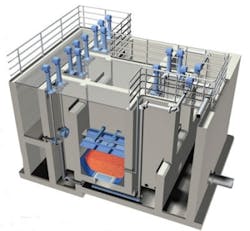Micro Media Filtration Proving Effective in RO, Ion Exchange Pretreatment
By George Di Falco
Having an effective, durable water pretreatment system in advance of reverse osmosis (RO) or ion exchange systems is the first, most critical line of defense – ensuring smoother, more trouble-free performance downstream. It’s especially true when dealing with today’s RO and ion exchange technologies, which require total suspended solids of 0.1-0.5 mg/L, turbidities of 0.1-1 NTU and silt density index values of less than five, and ideally less than three.
There is no such thing as a standard pretreatment process. Direct media filtration, multimedia filtration, microfiltration and ultrafiltration have all be used successfully. All have their own challenges.
In recent years, multi-media filtration has advanced considerably – now boasting superior filtration relative to conventional media filters and filtration efficiency approaching levels similar to ultra filters and micro filters.
Combining greater filtration efficiency with the durable nature of media filtration means a significant reduction in cleanings, overall downtime, and many other related costs for plants.
One example is a system offered by design and manufacturing firm Eco-Tec Inc. The company’s Spectrum Micro Media system is basically a two-layer depth media filter with a number of features that depart from conventional designs; namely, a coarse media upper layer of either anthracite or nutshells, and a fine micro-media lower layer.
The lower, fine micro-media layer is the key feature compared to conventional designs. While dual media filters typically employ silica sand with an effective size of about 0.35 mm, the Spectrum filter uses a lower layer of high density media with an effective size of less than 0.1 mm.
The flow channels through the micro media are extremely small and the tortuous path of fine channels provides excellent retention of solids. The micro media is much heavier in density than coarse media which ensures that it reclassifies (resettles below the coarse media after backwashing) and is virtually impossible to backwash out of the filter vessel.
The top layer consists of coarse anthracite – similar to, but somewhat finer than that used in conventional dual media filters – and provides the bulk of the solids retention and therefore defines the run length.
Case Study
Among a number of Spectrum filters installed in the field over the past few years, mostly on surface water applications, one example reflecting its effectiveness can be seen at the Water Treatment Plant (WTP) at the Ontario Power Generation’s Pickering Nuclear Generating Station (PNGS), an eight-unit nuclear station located near the shore of Lake Ontario, in the City of Pickering, Ontario, Canada. Eco-Tec Inc., a Pickering-based company, supplies the equipment and operates the WTP.
Since the WTP was commissioned in October 2001, it has continuously supplied the normal water requirements of the nuclear power plant without the need for supplemental demineralized water from other sources. During the first few months of operation, the WTP experienced some teething pains. It was found that the feed water turbidity excursions, along with the presence of silt and sand were considerably higher, more frequent, and prolonged than was originally anticipated.
Yet, the micro media filters responded well in terms of their ability to produce a high quality filtrate despite turbidities exceeding 100 NTU on a number of occasions.
The true testament to the effectiveness of the filters is that the reverse osmosis membranes downstream did not need to be replaced until 4-5 years after initial installation – a significant accomplishment considering the condition of the surface water feeding the plant.
Because of the improved filtration efficiency associated with the micro-media, it is possible to operate the filters at higher loading flow rates. A conventional filter may operate at 4 to 8 gpm/ft2 while the Spectrum filter is run at 14 to 18 gpm/ft2. As a result of this higher flow rate the vessel diameter to treat a given flow rate is reduced.
About the Author: George Di Falco is Communications Coordinator, Eco-Tec, Inc. He has had numerous technical features published in the energy, manufacturing, and environmental-science sectors.


